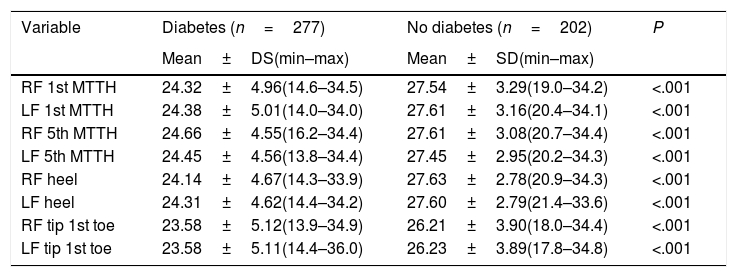The objective of the study is to analyze, through the use of infrared thermography, the variability of foot temperature in diabetic and non-diabetic patients by segmenting the sole of the foot in four study areas.
MethodA cross-sectional study was proposed on a sample of 479 subjects divided into two groups, a group of people with diabetes and a group of people without diabetes. The diabetes group comprised a total of 277 people, with an average age of 63.41 years [138 men (49.8%) and 139 women (50.2%)], and the group without diabetes comprised 202 individuals, with an average age of 61.92 years [99 men (49%) and 103 women (51%)]. The images were taken using the FLIR E60bx® camera. IBM SPSS Statistics 22 software was used for the statistical data analysis.
ResultsThe results show temperature variability in the different areas of study of the sole of the foot bilaterally and there were also differences according to whether the patient belonged to the diabetic or the non-diabetic group.
ConclusionsThe use of infrared thermography in the evaluation of the foot at risk could demonstrate the variability of temperature by study area, which could be useful in the area of healthcare for the diagnosis and prevention of injuries to compromised areas of the foot.
El objetivo del estudio es analizar, mediante el uso de termografía infrarroja, la variabilidad de temperatura del pie en pacientes diabéticos y no diabéticos tras la segmentación de la planta del pie en 4 áreas de estudio.
MétodoSe planteó un estudio transversal sobre una muestra de 479 sujetos encuadrados en 2 grupos, grupo personas con diabetes y grupo personas sin diabetes. El grupo de diabetes, compuesto de un total de 277 personas, con una edad media de 63,41 años (138 hombres [49,8%] y 139 mujeres [50,2%]), y el grupo sin diabetes con 202 individuos, con una edad media de 61,92 años (99 hombres [49%] y 103 mujeres [51%]). La toma de imágenes se llevó a cabo con la cámara FLIR E60bx®. El análisis estadístico de los datos obtenidos se realizó utilizando el paquete estadístico IBM SPSS Statistics 22.
ResultadosLos resultados mostraron variabilidad de temperatura en las distintas áreas de estudio de la planta del pie de forma bilateral, y también hubo diferencias según la pertenencia al grupo de pacientes diabéticos o no diabéticos.
ConclusionesEl uso de termografía infrarroja en la evaluación del pie de riesgo podría demostrar la variabilidad de temperatura por áreas de estudio, lo que puede ser de utilidad para el diagnóstico y prevención de lesiones en zonas comprometidas del pie.









